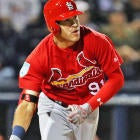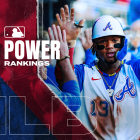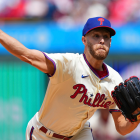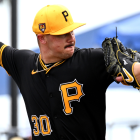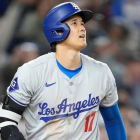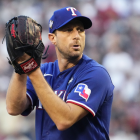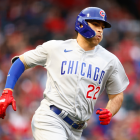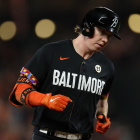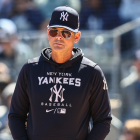We don't yet know the parameters of the 2020 season, should we be lucky enough to have one, but we already know one of the key decisions that will be made. It's one that could, without exaggeration, help determine the outcome of the National League Central. That decision is how the Cardinals will sort out their outfield competition.
The division will be a hotly contested one -- the Cardinals, Brewers, Cubs and Reds all profile as potential contenders but none as a runaway favorite -- and the regular season will be shorter, which raises the stakes for decisions such as this one. The January trade that sent Jose Martinez and Randy Arozarena to the Rays provided a bit of clarity, but it's still a somewhat muddled situation. While names like Lane Thomas, Austin Dean and Justin Williams may yet be heard from, the starting three will almost certainly come from a group of five -- Harrison Bader, Dexter Fowler, Tyler O'Neill, Tommy Edman and Dylan Carlson. Now let's sort out how this should be, you know, sorted out.
Bader's glove means he should be the regular in center
Bader's production with the bat declined significantly last season, but he remains a standout defender in the vital position of center field. Last season, Bader ranked fourth among MLB outfielders in defensive outs above average, and that was despite his playing just 122 games. He was even better in 2018, so this is an established skill on his part that also passes the eye test. Bader is so good with the glove -- while also being a plus baserunner -- that he merits a spot in the lineup on a daily basis. In other words, he moves the needle in the preferred direction even when he's not hitting.
If you look at Bader's quality-of-contact indicators from last season, then you'll conclude that he was probably a little unlucky in 2019. That may portend some improvement at the plate in 2020. The larger point, though, is that he's such a difference-maker in center that his bar for offensive adequacy is lower than it is for most. Barring complete offensive collapse, Bader should be the primary in center for all of 2020. At times, he's also shown the ability to lay off the same-side breaking stuff that's plagued him throughout his career. Maybe there's the potential for growth with the bat, as he's yet to reach 1,000 plate appearances in MLB.
The Cardinals need to see what they have in O'Neill
O'Neill has been in the St. Louis outfield discussion since he was acquired from the Mariners in July of 2017 in exchange for Marco Gonzales. He boasts elite sprint speed and can be a defensive asset at the corners, and he's also shown pop across 121 games at the big-league level. The pop is legit, as his minor league dossier proves, and O'Neill has 30-homer potential if allowed to play every day. Playing every day, though, has been an elusive goal for the 24-year-old. He's been back and forth between the majors and minors, and he's landed on the IL four times in two seasons. That said, O'Neill remains a tantalizing mix of power and speed, and the Cardinals badly need to see if he can find his ceiling in the majors. Only consistent playing time will allow that to happen.
For his MLB career, O'Neill has drawn just 17 unintentional walks in 293 plate appearances. In his offseason training he focused on improving his selectivity, and before Grapefruit League play was shut down he indeed showed a much more patient approach at the plate (the usual sample size and quality of competition spring caveats apply, of course).
Last season in the bigs, O'Neill swung at pitches outside the strike zone 37.2 percent of the time versus an MLB-average mark of 31.6 percent of the time. What's even more glaring is that he made contact on pitches outside the zone just 43.5 percent of the time versus an MLB average of 62.7 percent. That's a huge difference, and he was even worse in that regard in 2018. O'Neill's always going to have swing and miss in his game, but he doesn't have the bat-to-ball skills to get away with such an expanded swing zone. That's why the spring results, however easily dismissed, are at least somewhat encouraging. Plate discipline indicators tend to stabilize pretty early, so we may know sooner than you might think whether O'Neill's work has yielded sustainable improvements. That will be essential to unlocking his power at the highest level. Given his power ceiling and the Cardinals' need for more thump in an offense that last season ranked 12th in the NL in home runs and slugging percentage (also recall that Marcell Ozuna took some of that power with him to Atlanta), O'Neill needs to be installed as a regular until he makes good or bad on his potential with the bat.
Fowler is coming off a bounce-back year, but ...
Fowler would seem to have a path to at least semi-regular playing time because he's a favorite of manager Mike Shildt, and he's still under contract through 2021. As well, Fowler's coming off a rebound campaign at the plate in 2019. That latter point is an important one.
In reality, it's a rebound that is made to look more impressive by the depths Fowler reached in 2018. That year, his season was cut short in early August by a foot injury, and at the time he went down Fowler owned a grim slash line of .180/.278/.298. That comes to an OPS+ of just 59, which is compared to Fowler's pre-2018 career mark of 109. Obviously, that's an unacceptable level of production.
Then came 2019. Fowler played 150 games for the NL Central champs, and he lifted his slash line to .238/.346/.409 with 19 home runs and 73 unintentional walks. That's a massive improvement over his 2018 outputs, but in the end his 2019 line yielded an OPS+ of just 98. In other words, Fowler produced at just below a league-average clip at the plate while being a defensive liability. Simply put, a 98 OPS+ from a primary corner defender who gives back runs in the field isn't anything special. Yes, Fowler was vastly better than he was in 2018, but that says more about 2018 than it does 2019.
This isn't to suggest that Fowler has no place on the roster. He's a disciplined hitter who can run into one on occasion. His basement-level exit velocity doesn't bode well going forward, especially now that he's 34 years of age, but he can work enough walks to be useful in the proper role. The proper role is as a fourth outfielder. He's a switch-hitter who can spot all three outfield positions -- albeit not well -- and there's a place for that, especially with the active rosters expanded to 26 (or maybe more, depending upon the one-off roster rules for 2020). The simple reality, though, is that Fowler in 2020 is likely to be stretched as a lineup regular, and that's particularly so given the other options that the Cardinals have. Reducing the role of a high-character veteran like Fowler surely won't be a comfortable decision for Shildt, but it's likely what needs to be done.
Carlson's upside is unmatched
The 21-year-old Carlson has already established himself as one of the top position prospects in all of baseball (our own R.J. Anderson tabbed Carlson as the No. 22 overall prospect in baseball following last season). For his career, he owns a line of .260/.350/.431 across parts of four minor-league seasons, and last year he authored an OPS of .914 at the Double- and Triple-A levels with 26 home runs, 28 doubles, and 20 stolen bases in 126 games. That production at the highest rungs plus his impressive scouting profile mean the switch-hitter and former first-rounder is ready for the majors. Carlson backed up those assumptions with a .313/.436/.469 line before the spring training shutdown with six walks against five strikeouts in 39 plate appearances.
On another level, the switch-hitting Carlson has thus far been stronger from the left side (that tracks, since he throws left-handed), and the Cardinals could use additional lefty pop in the lineup. That goes doubly if Matt Carpenter doesn't enjoy a rebound at the plate in 2020. As for outlooks, projection systems are conservative by nature, and that's why you're going to see Carlson projected similarly to Fowler for 2020. Carlson, though, provides vastly more upside than does Fowler at this stage of their respective careers. As such, Carlson has a better chance of outplaying those projections than Fowler does, and his "upper bound" outcome is going to be higher than Fowler's. The Cardinals lineup is starved of a true middle of the order threat right now, barring a Paul Goldschmidt renaissance. Carlson, though, gives them a playable chance at getting that kind of production in 2020 -- not likely, necessarily, but playable. He has to play, though. You don't add Carlson to the 40-man and then active roster unless you're going to make him a primary.
Edman is best deployed as a 'super sub'
Edman as a rookie in 2019 provided stretch-drive production, spark and defensive utility beyond anyone's hopes. Edman spent most of his time in the infield last season, but he has the potential to be an asset with the glove at all three outfield positions. That said, Edman's defensive flexibility means he's probably best used as a Ben Zobrist type. As well, the likelihood that he regresses offensively also needs to be taken into account (last season's production was out of step with anything he's done before as a pro). If Carpenter continues the decline we first glimpsed last season, then Edman will be needed at the hot corner. Until that comes to pass -- or until he's truly needed in the outfield because of injury or ineffectiveness -- he's best utilized as a high-usage reserve.
The prediction is that Shildt goes with Bader in center, Fowler in right and O'Neill in left. It says here he should indeed use Bader and O'Neill as starters but instead favor Carlson's upside over Fowler for the third starting job. Whatever he decides coming out of camp -- whatever camp looks like -- it'll be justifiable. No alignment makes a great deal more sense than any other, which speaks to the fact that the Cardinals right now don't have a true star in the outfield. Carlson, though, could become that star as early as 2020, which is why Shildt needs to make the difficult decision to ramp down Fowler's role. Whether that happens is, as noted above, a very vital matter for the reigning NL Central champs.













